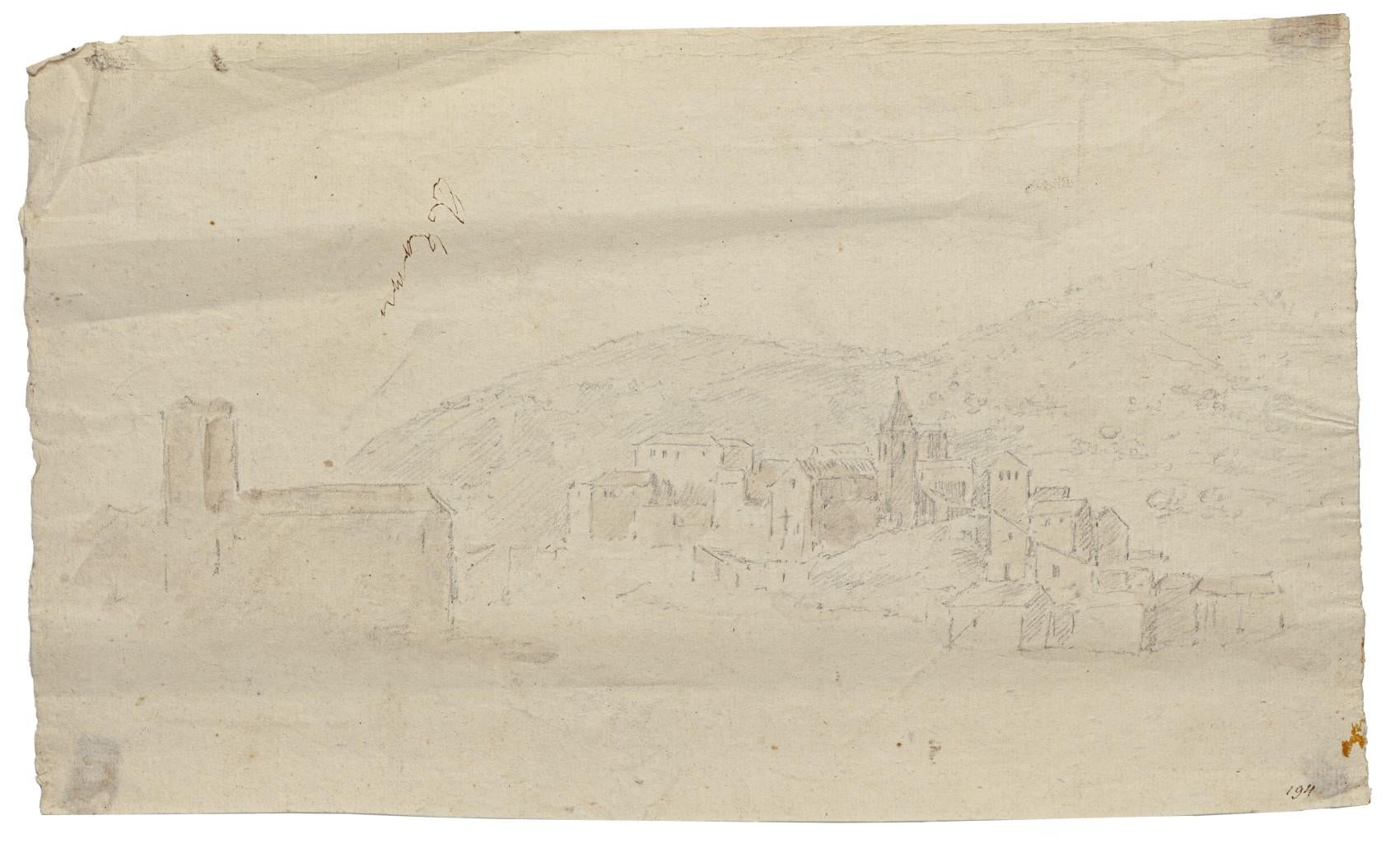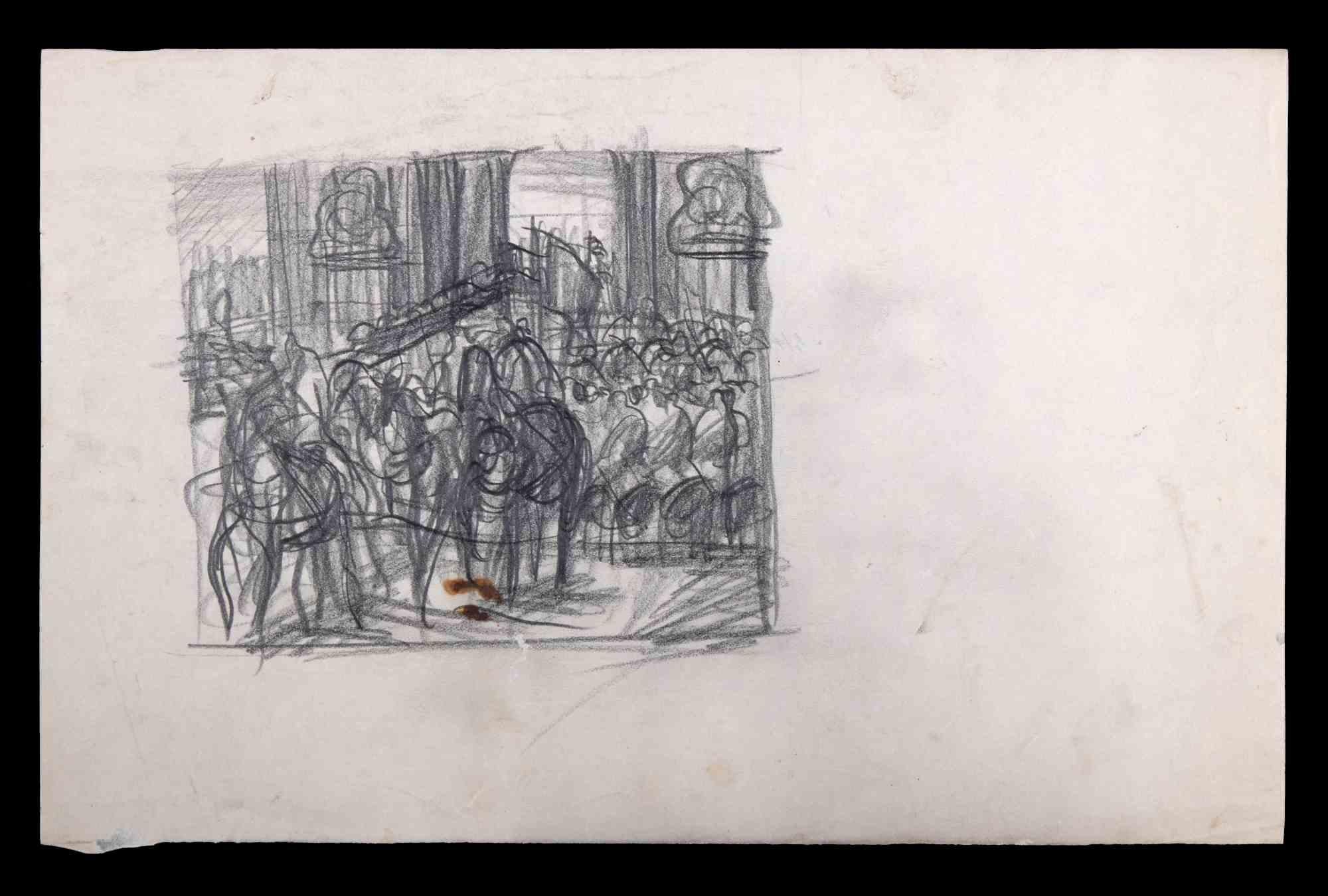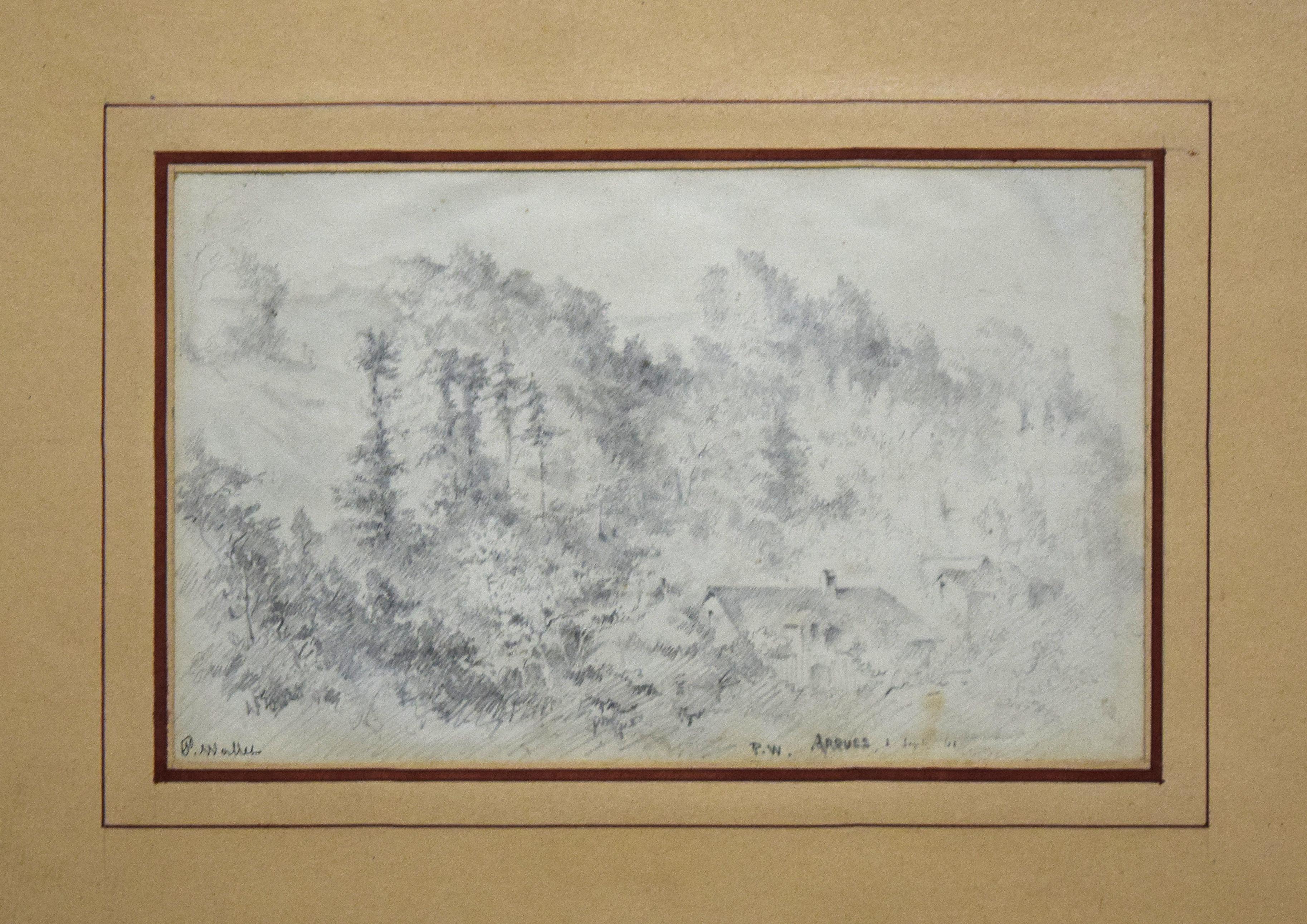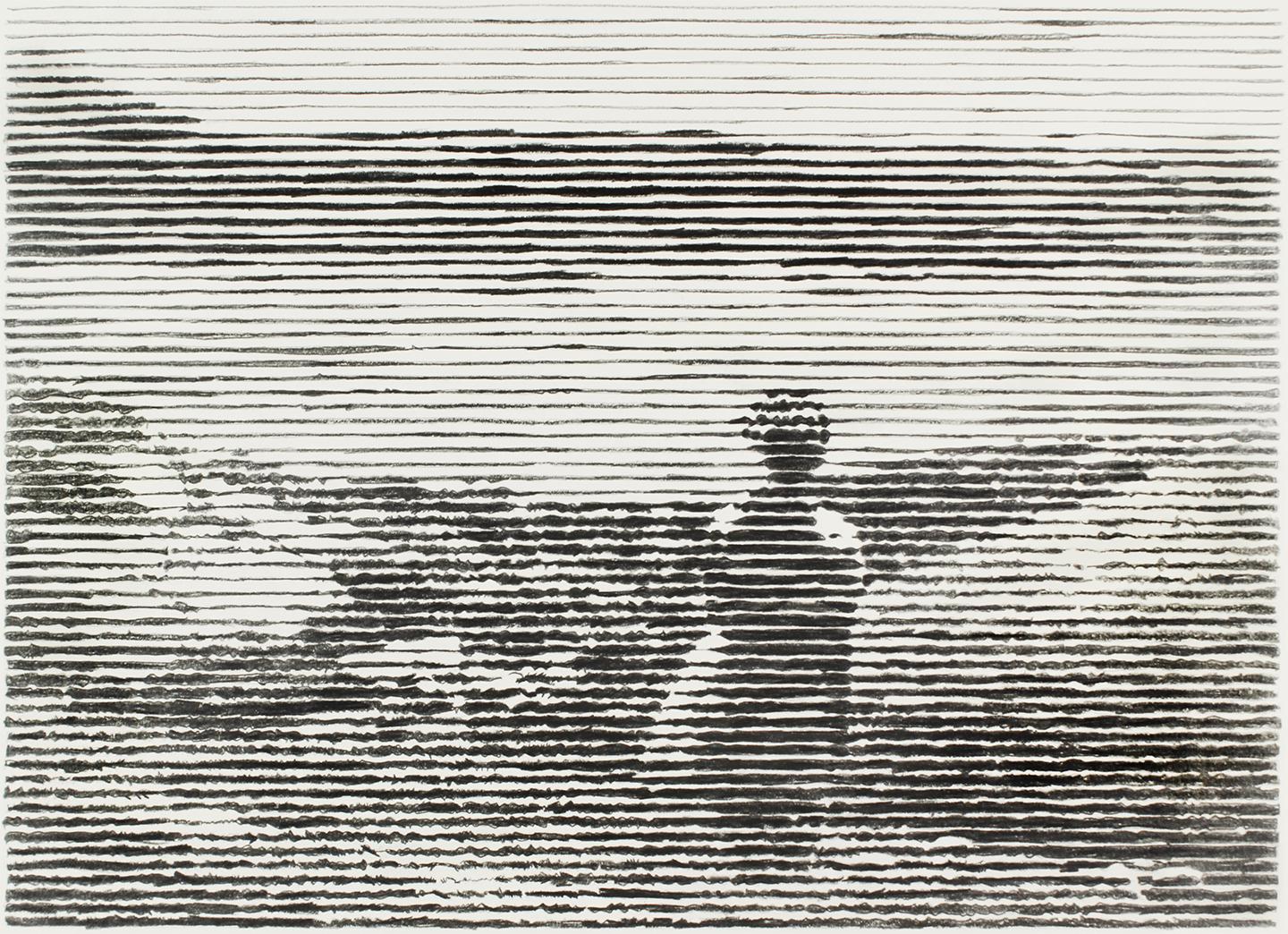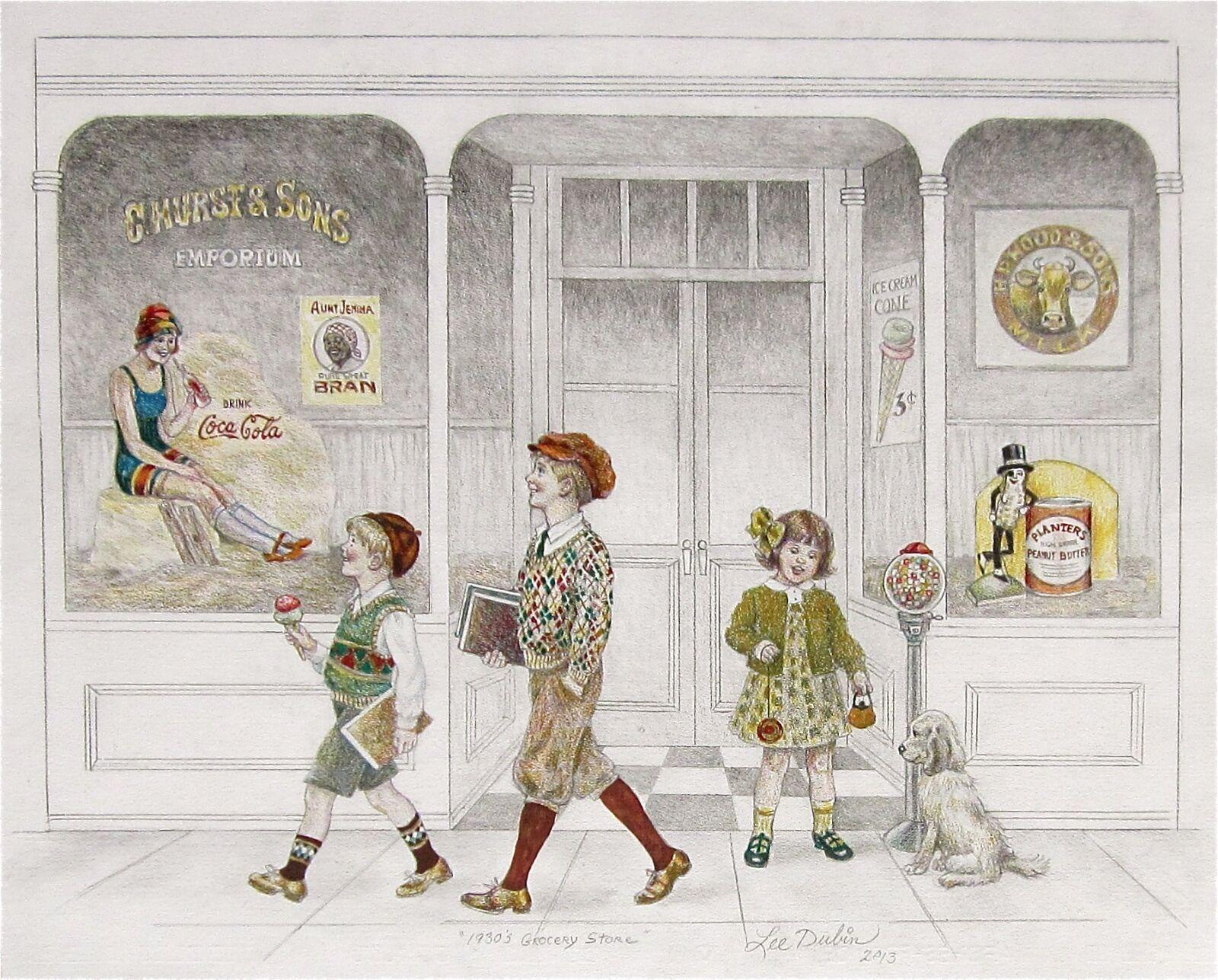Items Similar to Maison Forte Cheyrac - Pencil Drawing by A. R. Brudieux - 1960s
Want more images or videos?
Request additional images or videos from the seller
1 of 2
André Roland BrudieuxMaison Forte Cheyrac - Pencil Drawing by A. R. Brudieux - 1960s1960s
1960s
About the Item
Maison Forte Cheyrac is a pencil drawing on paper, realized around 1960s by the French artist André Roland Brudieux (1921-1999).
Monogrammed in pencil "ARB“ on the lower right margin.
Representing a splendid view of the Cheyrac Castle, a fortress that may have belonged to Polignac, with a view of the Italian gardens, with a rapid sign and delicate nuances, this modern artwork is in very good conditions, including a cardboard passepartout (cm 34 x 49).
On the back, "Ladrat" written in pencil, as generally the artists-travelers report on the sketches.
André Roland Brudieux (Saint-Moreil, Creuse, France, 1921 – Paris, 1999)
The French artist spent his youth in Vendôme, in the departement of Loire-et-Cher, where he worked as a wallpaper stenciller. In 1939 he began to engrave and, in 1941, moved to Paris, studing at the École du Louvre between 1945-1957.
Talented draftsman and sensitive artist, André Roland Brudieux was a member of Surrealist mouvement, gravitating around André Breton and participating in Surrealist exhibitions in 1950. He also began to experiment the woodcut technique in 1997. Best-known as engraver or draftsman of natural landscapes, he was also a writer, who attended the great Parisian salons, and a collector of old wallpapers and artwork.
- Creator:
- Creation Year:1960s
- Dimensions:Height: 11.82 in (30 cm)Width: 9.45 in (24 cm)Depth: 0.04 in (1 mm)
- Medium:
- Period:
- Framing:Framing Options Available
- Condition:Insurance may be requested by customers as additional service, contact us for more information.
- Gallery Location:Roma, IT
- Reference Number:
About the Seller
4.9
Platinum Seller
These expertly vetted sellers are 1stDibs' most experienced sellers and are rated highest by our customers.
1stDibs seller since 2017
6,830 sales on 1stDibs
Typical response time: 4 hours
- ShippingRetrieving quote...Ships From: Grasse, France
- Return PolicyA return for this item may be initiated within 14 days of delivery.
More From This SellerView All
- Landscape - Watercolor and Pencil by Jan Peter Verdussen - 18th CenturyBy Jan Peeter VerdussenLocated in Roma, ITLandscape is a beautiful dranwing in watercolor and pencil on ivory-colored paper realized by Jan Peter Verdussen. In good condition; only a sma...Category
18th Century Old Masters Landscape Drawings and Watercolors
MaterialsWatercolor, Pencil
- Sketches - Original Drawing by Unknown - Mid 20th CenturyLocated in Roma, ITSketches is an Original Pencil Drawing realized by an Unknown artist in mid-20th century. Good condition on a yellowed paper. No signature.Category
Mid-20th Century Modern Figurative Drawings and Watercolors
MaterialsPencil
- Arques - Pencil Drawing by Paul Louis Aleandre WalletLocated in Roma, ITArques is an original artwork realized by paul Louis Alexandre Wallet in 1861. Pencil on paper. Hand-signed by the artist on the lower left; monogramed, titled and dated by the artis...Category
Mid-19th Century Figurative Drawings and Watercolors
MaterialsPencil
- Sketches of People - Original Drawing by Unknown - Mid 20th CenturyLocated in Roma, ITSketches of People is an Original Pencil Drawing realized by an Unknown artist in mid-20th Century. Good condition on a yellowed paper. No signature.Category
Mid-20th Century Modern Figurative Drawings and Watercolors
MaterialsPencil
- Sailboats - Original Drawing by Madeleine Scali - 1982By Madeleine ScaliLocated in Roma, ITSailboats is an Original Pencil Drawing realized by Madeleine Scali on 1982. The little beautiful artwork is in very good condition. Hand-signed and dated by the artist on the lowe...Category
1980s Modern Figurative Drawings and Watercolors
MaterialsPencil
- Sketches of Workers - Original Drawing by Unknown - Mid 20th CenturyLocated in Roma, ITSketches of Workers is an Original Pencil Drawing realized by an Unknown artist in mid-20th century. Good condition on a yellowed paper. No signature.Category
Mid-20th Century Modern Figurative Drawings and Watercolors
MaterialsPencil
You May Also Like
- Mom (Lake Hemet?), black and white portrait of woman looking out at landscapeBy Charles BuckleyLocated in New York, NYCharles Buckley sources images from the fifties and using acrylic ink, carefully renders familiar scenes of the everyday with lines of varying thicknesses. The subjects run the gamut...Category
2010s Contemporary Figurative Drawings and Watercolors
MaterialsGraphite, Paper
- Grocery Store (1930s), Lee DubinBy Lee DubinLocated in Fairfield, CTArtist: Lee Dubin Title: Grocery Store (1930s) Year: 2013 Medium: Watercolor and graphite on paper Size: 19.5 x 24 inches Condition: Excellent Inscriptio...Category
2010s American Realist Figurative Drawings and Watercolors
MaterialsGraphite, Color Pencil
- Landscape with Gate by Orovida Pissarro - DrawingBy Orovida PissarroLocated in London, GB*UK BUYERS WILL PAY AN ADDITIONAL 20% VAT ON TOP OF THE ABOVE PRICE Landscape with Gate by Orovida Pissarro (1893-1968) Pencil on paper 25.7 x 20.4 cm (10 ¹/₈ x 8 inches) Executed circa 1917 Artist biography: Orovida Camille Pissarro, Lucien and Esther Pissarro’s only child, was the first woman in the Pissarro family as well as the first of her generation to become an artist. Born in Epping, England in 1893, she lived and worked predominantly in London where she became a prominent member of several British arts clubs and societies. She first learned to paint in the Impressionist style of her father, but after a brief period of formal study with Walter Sickert in 1913 she renounced formal art schooling. Throughout her career, Orovida always remained outside of any mainstream British art movements. Much to Lucien's disappointment she soon turned away from naturalistic painting and developed her own unusual style combining elements of Japanese, Chinese, Persian and Indian art. Her rejection of Impressionism, which for the Pissarro family had become a way of life, together with the simultaneous decision to drop her famous last name and simply use Orovida as a ‘nom de peintre’, reflected a deep desire for independence and distance from the weight of the family legacy. Orovida's most distinctive and notable works were produced from the period of 1919 to 1939 using her own homemade egg tempera applied in thin, delicate washes to silk, linen or paper and sometimes embellished with brocade borders. These elegant and richly decorative works generally depict Eastern, Asian and African subjects, such as Mongolian horse...Category
1910s Post-Impressionist Figurative Drawings and Watercolors
MaterialsPaper, Pencil
- Women's Corner, Along the Cuyahoga River, Early 20th Century Cleveland SchoolBy Frank WilcoxLocated in Beachwood, OHFrank Nelson Wilcox (American, 1887-1964) Women's Corner, Along the Cuyahoga River, c. 1916 Watercolor and graphite on paper 21 x 29 inches Frank Nelson Wilcox (October 3, 1887 – April 17, 1964) was a modernist American artist and a master of watercolor. Wilcox is described as the "Dean of Cleveland School painters," though some sources give this appellation to Henry Keller or Frederick Gottwald. Wilcox was born on October 3, 1887 to Frank Nelson Wilcox, Sr. and Jessie Fremont Snow Wilcox at 61 Linwood Street in Cleveland, Ohio. His father, a prominent lawyer, died at home in 1904 shortly before Wilcox' 17th birthday. His brother, lawyer and publisher Owen N. Wilcox, was president of the Gates Legal Publishing Company or The Gates Press. His sister Ruth Wilcox was a respected librarian. In 1906 Wilcox enrolled from the Cleveland School of Art under the tutelage of Henry Keller, Louis Rorimer, and Frederick Gottwald. He also attended Keller's Berlin Heights summer school from 1909. After graduating in 1910, Wilcox traveled and studied in Europe, sometimes dropping by Académie Colarossi in the evening to sketch the model or the other students at their easels, where he was influenced by French impressionism. Wilcox was influenced by Keller's innovative watercolor techniques, and from 1910 to 1916 they experimented together with impressionism and post-impressionism. Wilcox soon developed his own signature style in the American Scene or Regionalist tradition of the early 20th century. He joined the Cleveland School of Art faculty in 1913. Among his students were Lawrence Edwin Blazey, Carl Gaertner, Paul Travis, and Charles E. Burchfield. Around this time Wilcox became associated with Cowan Pottery. In 1916 Wilcox married fellow artist Florence Bard, and they spent most of their honeymoon painting in Berlin Heights with Keller. They had one daughter, Mary. In 1918 he joined the Cleveland Society of Artists, a conservative counter to the Bohemian Kokoon Arts Club, and would later serve as its president. He also began teaching night school at the John Huntington Polytechnic Institute at this time, and taught briefly at Baldwin-Wallace College. Wilcox wrote and illustrated Ohio Indian Trails in 1933, which was favorably reviewed by the New York Times in 1934. This book was edited and reprinted in 1970 by William A. McGill. McGill also edited and reprinted Wilcox' Canals of the Old Northwest in 1969. Wilcox also wrote, illustrated, and published Weather Wisdom in 1949, a limited edition (50 copies) of twenty-four serigraphs (silk screen prints) accompanied by commentary "based upon familiar weather observations commonly made by people living in the country." Wilcox displayed over 250 works at Cleveland's annual May Show. He received numerous awards, including the Penton Medal for as The Omnibus, Paris (1920), Fish Tug on Lake Erie (1921), Blacksmith Shop (1922), and The Gravel Pit (1922). Other paintings include The Trailing Fog (1929), Under the Big Top (1930), and Ohio Landscape...Category
1910s American Modern Figurative Drawings and Watercolors
MaterialsGraphite, Watercolor
- Cows by Woodland Pond, Toledo, Ohio, Early 20th Century Cleveland SchoolBy Frank WilcoxLocated in Beachwood, OHFrank Nelson Wilcox (American, 1887-1964) Cows by Woodland Pond, Toledo, Ohio, c. 1920 Watercolor and graphite on board Signed lower right 22 x 30 inches Frank Nelson Wilcox (October 3, 1887 – April 17, 1964) was a modernist American artist and a master of watercolor. Wilcox is described as the "Dean of Cleveland School painters," though some sources give this appellation to Henry Keller or Frederick Gottwald. Wilcox was born on October 3, 1887 to Frank Nelson Wilcox, Sr. and Jessie Fremont Snow Wilcox at 61 Linwood Street in Cleveland, Ohio. His father, a prominent lawyer, died at home in 1904 shortly before Wilcox' 17th birthday. His brother, lawyer and publisher Owen N. Wilcox, was president of the Gates Legal Publishing Company or The Gates Press. His sister Ruth Wilcox was a respected librarian. In 1906 Wilcox enrolled from the Cleveland School of Art under the tutelage of Henry Keller, Louis Rorimer, and Frederick Gottwald. He also attended Keller's Berlin Heights summer school from 1909. After graduating in 1910, Wilcox traveled and studied in Europe, sometimes dropping by Académie Colarossi in the evening to sketch the model or the other students at their easels, where he was influenced by French impressionism. Wilcox was influenced by Keller's innovative watercolor techniques, and from 1910 to 1916 they experimented together with impressionism and post-impressionism. Wilcox soon developed his own signature style in the American Scene or Regionalist tradition of the early 20th century. He joined the Cleveland School of Art faculty in 1913. Among his students were Lawrence Edwin Blazey, Carl Gaertner, Paul Travis, and Charles E. Burchfield. Around this time Wilcox became associated with Cowan Pottery. In 1916 Wilcox married fellow artist Florence Bard, and they spent most of their honeymoon painting in Berlin Heights with Keller. They had one daughter, Mary. In 1918 he joined the Cleveland Society of Artists, a conservative counter to the Bohemian Kokoon Arts Club, and would later serve as its president. He also began teaching night school at the John Huntington Polytechnic Institute at this time, and taught briefly at Baldwin-Wallace College. Wilcox wrote and illustrated Ohio Indian Trails in 1933, which was favorably reviewed by the New York Times in 1934. This book was edited and reprinted in 1970 by William A. McGill. McGill also edited and reprinted Wilcox' Canals of the Old Northwest in 1969. Wilcox also wrote, illustrated, and published Weather Wisdom in 1949, a limited edition (50 copies) of twenty-four serigraphs (silk screen prints) accompanied by commentary "based upon familiar weather observations commonly made by people living in the country." Wilcox displayed over 250 works at Cleveland's annual May Show. He received numerous awards, including the Penton Medal for as The Omnibus, Paris (1920), Fish Tug on Lake Erie (1921), Blacksmith Shop (1922), and The Gravel Pit (1922). Other paintings include The Trailing Fog (1929), Under the Big Top (1930), and Ohio Landscape...Category
1920s American Modern Figurative Drawings and Watercolors
MaterialsWatercolor, Graphite
- Raising the wreck of the steamer Flushing at Hampton Roads, VirginiaLocated in Middletown, NYLikely a study for an illustration for Harper's Weekly, for which Wiser was a Civil War-era illustrator, focusing on shipwrecks and battles occurring along the mid-Atlantic coast. ...Category
Mid-19th Century American Realist Figurative Drawings and Watercolors
MaterialsArchival Paper, Graphite
Recently Viewed
View AllMore Ways To Browse
Forte Forte
Old Vintage Pencils
Andre Breton
Old Vintage Castles
Parisian Sketch
French Wallpaper Vintage
French Wallpapers Vintage
1950 Wallpaper
Chers French
Vintage R Monogram
Andre Roland
Wallpaper Sketches
Italian Vintage Wallpaper
Ruth Stewart Painting
Self Playing Baby Grand
Sippy Cups
Sylvestre Bruly Bouabre
Used Cherry Pickers
